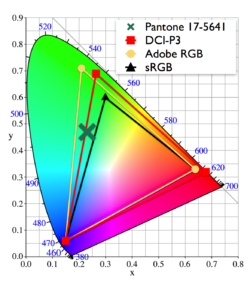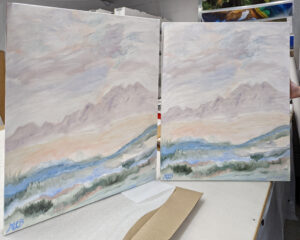Making good color reproductions of artwork takes excellent equipment, the appropriate software, skill and a knowledge of how color is rendered in each step of the digitization process. This post will help you understand why certain colors and/or elements of artwork reproduce well or poorly using the best available methods of professional digital technology and Inkjet/giclée printing. Make sure you read all the way to the bottom where there are several useful FAQs.
What is my color gamut?
First an understanding of color space or COLOR GAMUT is necessary. Think of color gamut as the palette of paints that you have available to create your artwork. For example, if you paint with oils you might paint with a limited palette: Cadmium Yellow, Alizarin Crimson, Cadmium Red, Cerulean Blue, Cobalt Blue and Titanium White. These colors when mixed can create every color including greens, purples, oranges, etc., giving you all colors but perhaps not the range or intensity you desire. If you add paint colors to expand your palette such as Viridian Green and Dioxazine Purple you expand the greens, purples and other colors you can mix, giving you more greens and purples to work with. So to continue this metaphor you have expanded your color gamut, your palette, to include a wider and more varied choice of color options. Simply stated, a color gamut is the variety and range of colors available.
In digitizing artwork the goal is to create a reproduction that gives the best representation of the original. The goal is to create a reproduction where all the color relationships are precise and the overall effect is color accurate. To do this each step in the digitization and printing process must capture the maximum amount of information and correctly translate that information. In an ideal world everything falls within the same color gamut.

It is important to understand that everything in the reproduction process has its own color gamut, the digitization camera/scanner, the computer monitor, the software, and the printer. For example, the camera in your phone utilizes a much smaller color gamut to capture an image than does a professional digital camera. So if you photograph your artwork with your phone you start with a small color gamut, that lost color information cannot be added back accurately later in the process. Also software like simple image preview software, and browsers like Chrome also use a much smaller color gamut than Adobe Photoshop or Adobe Lightroom. The images you take with your phone and upload to Instagram may look good in the uniformly limited color gamut of the internet, but they are not an accurate record of your artwork or ideal for accurate print reproduction.
A large color gamut is important because If a color in your piece of artwork falls outside the color gamut of either the digitization device (camera/scanner), or printer, that color will reproduce as the closest color in the gamut. That is why you want every device in the process to capture or reproduce the largest color gamut possible. At Digital Silver Imaging our inkjet/giclée printers use 11 pigment inks plus a chroma optimizer to print an extensive color gamut rendering the most accurate color possible. The average office or home printer typically uses 4 inks for a very small gamut.
Making the best reproduction of your art
So color reproduction is not as simple as clicking a button. The entire reproduction process must be designed and operated for color accuracy. Can you make color accurate reproductions in your own studio or home? Of course, but it takes the equipment and technical knowledge to make it all work.

We digitize your work using an ultra-high resolution Phase One camera, or full frame DSLR for large format work, and flat field lenses designed specifically for reproduction. We use Digital Heritage Capture One software, calibrated monitors, color accurate light sources, and Calibrite Color Checkers. Every step in our process has been designed to reproduce the most accurate color possible. The final step involves our expert staff that examines and makes those subtle changes that no software can.
FAQs
Can I choose the paper my reproduction is printed on?
Absolutely! We offer a wide variety of papers in many different surfaces. From ultra gloss to flat matte, to watercolor, and canvas. The paper you choose is an important part of the process. We offer papers from Canson, Hahnemühle, and Ilford.
Can I do my own digital capture and have you print it?
Yes. To get the best results please use a high quality digital camera, preferably one that has the ability to capture images in RAW format. Use a calibrated computer monitor to make any adjustments to your digital file and work in AdobeRGB color space.
Can you print from images I made with my iPhone/Smart Phone?
We can but because of the internal software in your phone, and the color space (gamut) used by phones it is difficult at times to make an accurate color reproduction. We ask that you don’t expect perfect color from a photo made with a phone.
Will the print paper I choose affect the color of my reproduction?
Yes. Different papers have slightly different base colors. In the world of paper different base colors are referred to as cool base, neutral or bright, and warm base (off-white to cream). Your base color slightly impacts all the color and white space in your print.
Can digital capture or Inkjet/giclée prints reproduce fluorescent or metallic paints and pigments?
Fluorescent or metallic paints use UV light and reflection to create more brilliance. In these situations some additional post production time maybe required to produce an image with increased saturation to approximate the feel of a fluorescent color. Metallics present the challenge of reflections, which are difficult to approximate. See our staff for specifics on your artwork.
What to you charge for your services?
